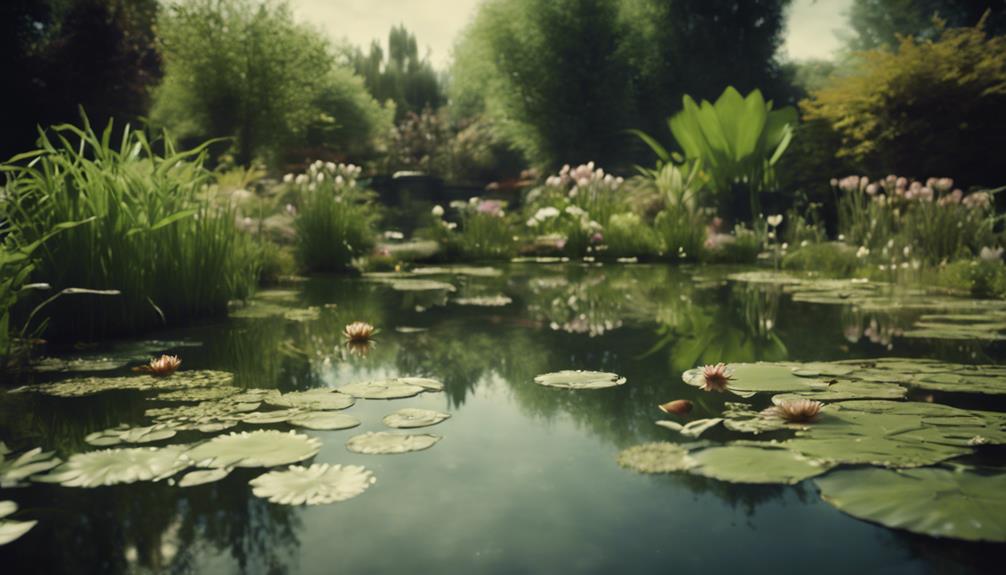When your garden pond's water turns murky or green, it's time to take action against algae growth. Identifying the type of algae present is essential, as each has unique characteristics and growth patterns. Excessive algae growth can lead to oxygen depletion, harming your fish and disrupting the pond ecosystem. To safely control algae, you'll need to understand the causes, manual and mechanical removal techniques, and natural prevention methods. By introducing beneficial microorganisms, nutrients, and aquatic plants, you can promote a balanced ecosystem and reduce algae growth. Continue to explore the most effective ways to maintain a healthy and thriving pond ecosystem.
Table of Contents
Key Takeaways
- Identify the type of algae present, as green water algae and string algae require different control methods.
- Implement manual and mechanical removal techniques, such as algae netting and filtration, to remove excess algae.
- Introduce natural algae prevention methods, including beneficial microorganisms, aquatic plants, and aeration, to create a balanced ecosystem.
- Monitor and maintain water quality by regularly testing pH, ammonia, nitrite, and nitrate levels to prevent nutrient imbalances.
- Use natural and safe treatments, such as barley straw and nutrient remediation solutions, to prevent algae blooms and maintain a healthy pond ecosystem.
Understanding Algae Types and Causes
As you examine your pond's ecosystem, you must understand that algae, the primitive plants responsible for oxygen production, come in two main forms: green water algae and string algae, each with distinct characteristics and growth patterns that contribute to oxygen depletion.
Green water algae are tiny, single-celled organisms that remain suspended in water, while string algae grows in long strands and adheres to rocks and waterfalls.
You might be surprised to learn that green water algae can be present in as many as five million cells per milliliter of pond water, whereas string algae can double their weight within 24 hours.
Both types of algae thrive in nutrient-rich pond water, which can lead to oxygen depletion.
Identifying the type of algae present in your pond is crucial, as each has unique characteristics and growth patterns.
Impact on Fish and Pond Ecosystem
When excessive algae growth occurs, you'll notice a decline in water quality, which can have devastating effects on the health and well-being of your fish and the overall pond ecosystem.
As algae blooms deplete oxygen levels, your fish may struggle to breathe, leading to stress, illness, or even death. In addition, algae growth can outcompete native aquatic plants for resources, disrupting the delicate balance of your pond ecosystem.
Fish health: Excess algae can lead to toxic compounds, threatening the health and well-being of your fish.
Ecosystem disruption: Algae blooms can alter the natural food chain, affecting the entire pond ecosystem.
Water quality decline: Excess nutrients fueling algae growth can lead to decreased water clarity, odor issues, and altered pH levels.
Pond aesthetic: Uncontrolled algae growth can turn your once-beautiful pond into a murky, uninviting environment.
Controlling algae growth is essential because it can have devastating consequences.
Manual Algae Removal Techniques

When it comes to manual algae removal techniques, you'll find that using the right tools makes all the difference.
You'll need to invest in specialized equipment, such as algae netting tools, to remove excessive algae growth from your pond's surface.
Algae Netting Tools
You'll need a reliable algae netting tool to manually remove excessive algae growth from your pond's surface, as this technique requires regular effort to maintain water quality. This is an essential step in preventing algae problems in your pond.
When choosing an algae netting tool, consider the following key features:
Mesh size: A smaller mesh size will help remove finer algae particles, while a larger mesh size is better for removing thicker algae mats.
Handle length: A longer handle will give you more reach and leverage to remove algae from the pond's surface.
Material durability: Look for durable, rust-resistant materials that can withstand frequent use in water.
Ease of cleaning: Opt for an algae netting tool with a design that allows for easy cleaning and maintenance to prevent the spread of algae.
Regular Water Skimming
Regular water skimming, an essential manual algae removal technique, involves daily removal of floating algae from the pond's surface to prevent its multiplication and subsequent sinking to the bottom.
By incorporating this technique into your Pond Algae Control routine, you'll be able to Remove Algae and prevent it from taking over your garden pond.
Skimming the surface of your pond daily, especially during peak algae growth seasons, can appreciably reduce the presence of green algae and small patches of filamentous algae.
This gentle and non-invasive method minimizes disturbance to fish and other aquatic life in the pond, making it an ideal solution for maintaining a healthy ecosystem.
As you skim the pond's surface, you'll notice an improvement in water clarity and a reduced likelihood of algae blooms.
By removing floating algae, you're preventing algae from sinking to the bottom and multiplying, which can lead to more severe water quality issues.
Mechanical Filtration Methods
By incorporating mechanical filtration methods into your pond maintenance routine, you can effectively remove debris, sediment, and algae from the bottom of the pond, creating a healthier environment for your fish and other aquatic life.
Mechanical filtration methods, such as using a pond vacuum, can be used to remove excess waste and algae cells from the pond floor. This helps to prevent the growth of new algae and reduces the risk of algae blooms.
Additionally, a well-designed filter system with appropriate filtration media can help to remove impurities from the water, further reducing the likelihood of algae growth.
Effective removal of debris and sediment: Mechanical filtration methods can remove unwanted material from the pond floor, creating a cleaner and healthier environment.
Reduced algae growth: By removing excess waste and algae cells, mechanical filtration methods can help to prevent the growth of new algae.
Gentle on fish: Mechanical filtration methods are gentle and minimize disturbance to fish, making them a safe and effective solution.
Can be used in conjunction with other methods: Mechanical filtration methods can be used in combination with other algae control methods, such as regular water skimming, to create a thorough pond maintenance routine.
Beneficial Pond Additives Explained

As you explore beneficial pond additives, you'll discover two key areas of focus: natural algae prevention and pond clarifying agents.
These additives can be a game-changer in your fight against algae, and you must understand how they work together to create a balanced ecosystem.
Natural Algae Prevention
You can prevent algae growth in your garden pond by introducing beneficial microorganisms and nutrients that promote a balanced ecosystem, thereby creating an environment where algae struggles to thrive.
By doing so, you'll help control algae growth and prevent excess nutrients from fueling its development. This balanced approach will allow your aquatic plants to flourish, creating a thriving ecosystem that's less conducive to algae growth.
Beneficial Bacteria: Introduce beneficial bacteria that break down excess nutrients, reducing the likelihood of algae growth.
Natural Barriers: Incorporate natural barriers like aquatic plants, which absorb excess nutrients and provide shade, making it difficult for algae to grow.
Aeration: Improve water circulation and oxygen levels through aeration, making it harder for algae to thrive.
Organic Matter: Add organic matter like compost or peat moss to help absorb excess nutrients and promote a balanced ecosystem.
Pond Clarifying Agents
How do beneficial pond additives, such as natural enzymatic treatments and barley straw, help clarify and maintain a healthy pond ecosystem by controlling algae growth?
These pond clarifying agents work by accelerating the decomposition of organic matter, including algae, to prevent their growth. By introducing beneficial bacteria into the pond, you can break down organic waste and reduce excess nutrients that contribute to algae growth, providing an eco-friendly approach to algae control.
Barley straw, a natural pond clarifying agent, releases compounds that inhibit algae development, making it a safe and effective solution. These natural additives are safe for fish and other aquatic organisms, making them an ideal choice for maintaining a healthy and balanced pond ecosystem.
Regular use of beneficial pond additives can help maintain clear and healthy pond water, reducing the need for chemical treatments and minimizing the risk of algae blooms. By controlling algae growth, you can prevent excessive sunlight from fueling further growth and maintain good water circulation.
Additionally, UV light can be used to further aid in controlling algae. By incorporating these beneficial pond additives, you can create a thriving and balanced pond ecosystem.
Fish-Friendly Algae Control Options
As you work to control algae in your garden pond, don't overlook the valuable assets swimming beneath the surface. Certain species of fish, such as koi, goldfish, and grass carp, can be a valuable asset in controlling algae growth in your garden pond, as they feed on algae and help keep its population in check.
Aquatic plants incorporate plants into your pond to create competition for nutrients, limiting the availability of resources for algae and helping to control its growth.
Natural treatments use natural treatments like barley straw to prevent algae growth without harming fish or other aquatic organisms in the pond.
Pond structures strategically place pond structures, such as floating plants or install shade sails, to limit the amount of direct sunlight reaching the pond, thereby reducing algae growth.
Complementary approaches implement these fish-friendly methods in conjunction with, or in addition to, other approaches and contribute to long-term algae control in your garden pond.
Monitoring and Maintenance Essentials

As you work to control algae in your garden pond, it's vital that you regularly monitor and maintain the ecosystem to prevent issues from arising.
You'll need to perform routine pond water quality checks to maintain the environment remains balanced and healthy.
Pond Water Quality Checks
You must perform regular water quality checks to maintain your pond's ecosystem remains balanced and healthy. As a responsible pond owner, monitor the water conditions in your water gardens to prevent Excessive Algae growth, which can harm the aquatic life and the overall ecosystem.
Regular pond water quality checks help you identify any imbalances in the water chemistry, allowing you to take corrective measures before the situation gets out of hand.
Some key parameters to check include:
pH levels: Verify the pH level is between 6.5 and 8.5 for healthy water.
Ammonia levels: Monitor ammonia levels to prevent toxicity in your pond.
Nitrite and nitrate levels: Balance these nutrients in your pond to prevent algae growth.
Oxygen levels: Maintain sufficient oxygen levels, especially in the surface area, to support aquatic life.
Performing regular water quality checks is crucial to identify any imbalances in the water chemistry, allowing you to take corrective measures before the situation gets out of hand.
Regular Cleaning Schedules
Establishing a regular cleaning schedule is essential to maintaining a healthy pond ecosystem, as neglecting this crucial aspect can lead to the accumulation of debris and excess nutrients that fuel algae growth.
You'll want to remove any visible debris, such as floating leaves or twigs, at least once a week. This will prevent them from sinking to the bottom and becoming a nutrient-rich food source for algae.
Regularly clean your water lilies and other floating plants to prevent debris accumulation. Submerged plants, like anacharis, can also be cleaned or replaced as needed.
Be mindful of overfeeding your fish, as uneaten food can contribute to excess nutrients. Consider implementing a biological filter to help break down organic matter and remove excess nutrients.
Early Warning Signs
By monitoring your pond's water parameters and observing its inhabitants, you can detect early warning signs of impending algae blooms and take corrective action before they spiral out of control.
Regularly checking the pond's oxygen levels, nutrient concentrations, and sunlight penetration can help you identify potential issues. For instance, an overabundance of nutrients can trigger the growth of filamentous algae, while suspended algae can indicate poor water circulation.
Keep an eye out for these early warning signs:
Cloudy or discolored water: Suspended algae or high levels of organic matter can cause the water to appear cloudy or discolored.
Excessive algae growth on the surface of the pond: Filamentous algae can form thick mats on the surface, while single-celled algae can create a greenish hue.
Decreased oxygen levels: Low oxygen levels can stress fish and other aquatic life, making them more susceptible to disease.
Unusual changes in aquatic life behavior: Changes in feeding patterns, lethargy, or sudden deaths can indicate underlying water quality issues.
Balancing Nutrient Levels Naturally
Maintaining a delicate balance of nutrient levels in your pond is essential to preventing algae growth, as excess nutrients can fuel blooms and harm the ecosystem.
You can keep your pond's nutrient levels in check by utilizing natural methods. For instance, you can introduce aquatic plants like pickerelweed, sedges, and rushes, which not only add beauty to your pond but also absorb excess nutrients from the water.
Additionally, you can use aerators to increase diffused oxygen in the water, supporting beneficial aerobic bacteria that break down organic matter and consume excess nutrients.
Regular water testing will help you identify nutrient imbalances, allowing you to make targeted adjustments to prevent algae blooms and maintain a healthy ecosystem.
You can also consider using nutrient remediation solutions like lanthanum-modified clay to permanently remove phosphorus from the water column, a key contributor to algae growth.
Preventing Algae Blooms Proactively

To keep algae at bay, you'll want to focus on creating an environment that's not conducive to their growth.
Regular water testing: Monitor your pond's nutrient levels to catch any imbalances early on.
Adding aquatic plants: Incorporate floating plants like lilies and lotus to provide shade and reduce direct sunlight, and submerged plants like anacharis and hornwort to release oxygen and absorb nutrients.
Establish a protective buffer: Plant beneficial vegetation around your pond to stabilize the bank, reduce erosion, and absorb excess nutrients.
Implement a prevention program: Design a yearly plan that prioritizes balance and prevention, using natural and safe techniques to prevent algae blooms.
Chemical-Free Treatment Alternatives
Exploring chemical-free treatment alternatives for your garden pond allows you to maintain a pristine environment while avoiding harsh additives. As a pond owner, you want to create a thriving ecosystem for your fish and aquatic plants.
| Treatment | How it Works |
|---|---|
| UV Clarifier | Destroys ultrafine particles, eliminating discolored water |
| Barley Straw | Releases compounds that inhibit algae growth, maintaining clear water |
| Beneficial Bacteria | Consumes excess nutrients and organic matter, preventing algae blooms |
| Natural Enzymatic Treatments | Accelerates decomposition of organic matter, including algae |
These alternatives are not only safe for your pond's inhabitants but also promote a balanced ecosystem. For instance, barley straw is a natural and non-toxic way to remove algae, while beneficial bacteria can be introduced to consume excess nutrients. Natural enzymatic treatments, on the other hand, accelerate the decomposition of organic matter, including algae. By incorporating these chemical-free treatments, you'll be able to enjoy a clear and healthy pond without compromising the well-being of your fish and aquatic plants.
Explore the following effective and eco-friendly solutions:
UV Clarifier, Barley Straw, Beneficial Bacteria, and Natural Enzymatic Treatments.
Frequently Asked Questions
How to Prevent Algae in a Garden Pond?
To prevent algae in your pond, you'll want to maintain proper Pond Balance through Regular Maintenance, ensuring good Water Clarity and Pond Aeration, while using Algae Barriers, Nutrient Control, and Eco Friendly Methods to keep your pond healthy and thriving.
How to Remove Algae From a Pond Without Harming Fish?
You can remove algae from your pond without harming fish by using pond vacuums, manual removal, or introducing algae eaters; also, consider incorporating algae nettles, fish shelters, UV filters, and regular water changes to create a balanced ecosystem.
What Can You Put in a Pond to Kill Algae?
As you wade into the murky waters of algae control, you'll find a sea of solutions: algaecide products, barley straw, copper sulfate, hydrogen peroxide, algae magnets, pond clarifiers, and ultrasonic devices, each promising to vanquish the green menace and restore your pond's pristine glory.
Does Baking Soda Kill Algae in Ponds?
You'll find that baking soda doesn't directly kill algae, but rather raises pH levels, making it difficult for certain algae types to thrive; however, effectiveness depends on soda dosage, pH levels, and algae blooms, making it a nuanced natural remedy.
Conclusion
As you gaze upon your serene garden pond, remember that the delicate balance of nature is like a Shakespearean sonnet – one misstep can unravel the entire harmony.
By understanding algae types, manual removal techniques, and beneficial additives, you've taken the first steps towards a thriving ecosystem.
Now, with proactive maintenance and natural nutrient balancing, your pond will flourish like a well-tended garden, providing a tranquil oasis for you and your fish to enjoy.

